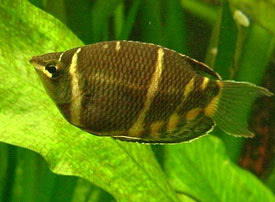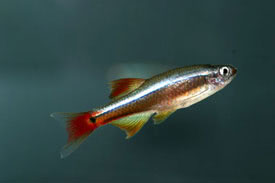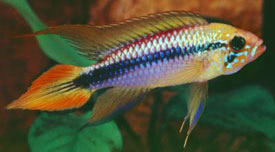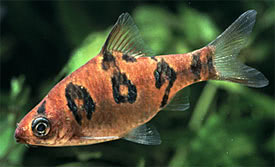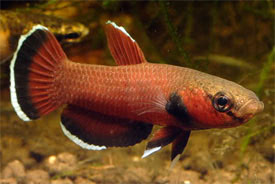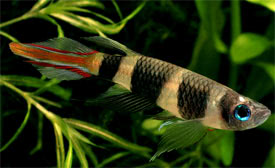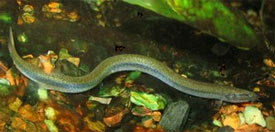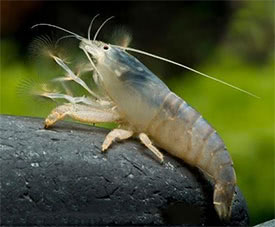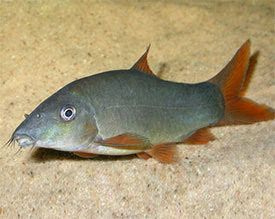
 Magyarul / Hungarian
Magyarul / Hungarian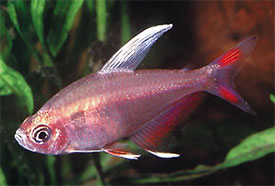
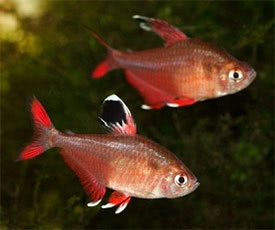

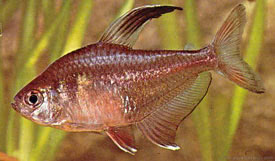
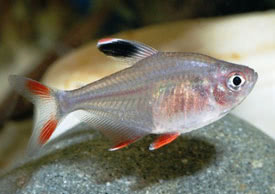

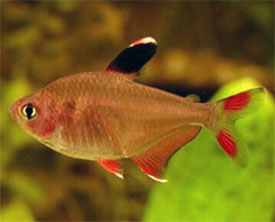
- Scientific name: Hyphessobrycon rosaceus
- Synonyms: Hyphessobrycon ornatus (Ahl, 1934), Cheirodon troemneri (Fowler, 1942)
- Common name: Rosy Tetra
- Group: Characins
- Habitat: South America; Guyana, Suriname and Brazil
- Size: 4 cm
- Biotope: Found in the lower Amazonas region, where they inhabit the forested areas in slow-flowing tributaries. These are usually blackwater streams with very soft and acidic water.
- Social behavior: A very peaceful, schooling fish, that can be kept in a community aquarium with similar sized other peaceful, south american fish. Always keep them in a small group.
- Diet: Omnivorous; in the nature they feed chiefly on invertebrates, while in the aquarium they will readily accept all kinds of live and frozen foods or good quality dried foods.
- Breeding: Very hard
- Tank: Minimum 70 litres
- Population: 6 fish for 70 litres
- Decoration: Arrange a biotope aquarium for them: use a river sand substrate with some driftwood and a few handfuls of dried leaves. The lighting shouldn’t be strong and the water can be filtered through peat. They can also be kept in a densely planted tank with dark substrate.
- Temperature: 24-28 °C
- pH: 5.5-7.5
- Hardness: 1-12 NK°
- Lifespan: 3-5 years
Description: The Rosy Tetra has a light pink-silvery body. The dorsal fin is black (some specimens have white tipped dorsal fins), or white, and the caudal fin has a red band on each lobe. The anal fin is mostly clear or reddish, but edged in black with the tip in white. It has a faint black line running through its eyes. Hyphessobrycon rosaceus is often confused with Hyphessobrycon bentosi, the two can be distinguished by a dark spot near to the gills on Hyphessobrycon bentosi but which is absent from Hyphessobrycon rosaceus.
Males develop extended dorsal and anal fins as they mature, and they are a little longer, slimmer and more colorful than females. The extended dorsal fin can almost reach the tail fin in older males.
They can be bred in a similar way to other Hyphessobrycon: a separate tank is needed if you want to raise decent numbers of fry. Use a 20-30 litres small aquarium with subdued lighting and cover the substrate with a few clumps of fine-leaved aquatic plants (such as Java moss) where the female can deposit its eggs. Other option is to cover the base of the aquarium with some kind of mesh with large enough grade so that the eggs can fall through it, that protect the eggs from the parents. The water should be very soft (1-5 gH°), acidic (pH 5.5-6.5) with a temperature of 27-28 °C. Rosy Tetras can be bred in a small group or in pairs, either way they should be conditioned with a variety of live and frozen foods. Always choose the best colored males and the plumper females, and place them into the breeding tank in the evening. The fish will usually spawn in the next morning. After spawning the aduls fish sould be removed from the tank because they will eat the eggs. The light-brown colored eggs hatch in 24-36 hours and the larvae become free-swimming after another 3-4 days. The tank should be protected from the bright lights, as eggs and the fry are light sensitive in the early stages of life, so the sides can be covered with newspaper. The fry develop quite quickly, and after 2 months they show adult colors, and they will reach sexual maturity at 6-8 months of age.





